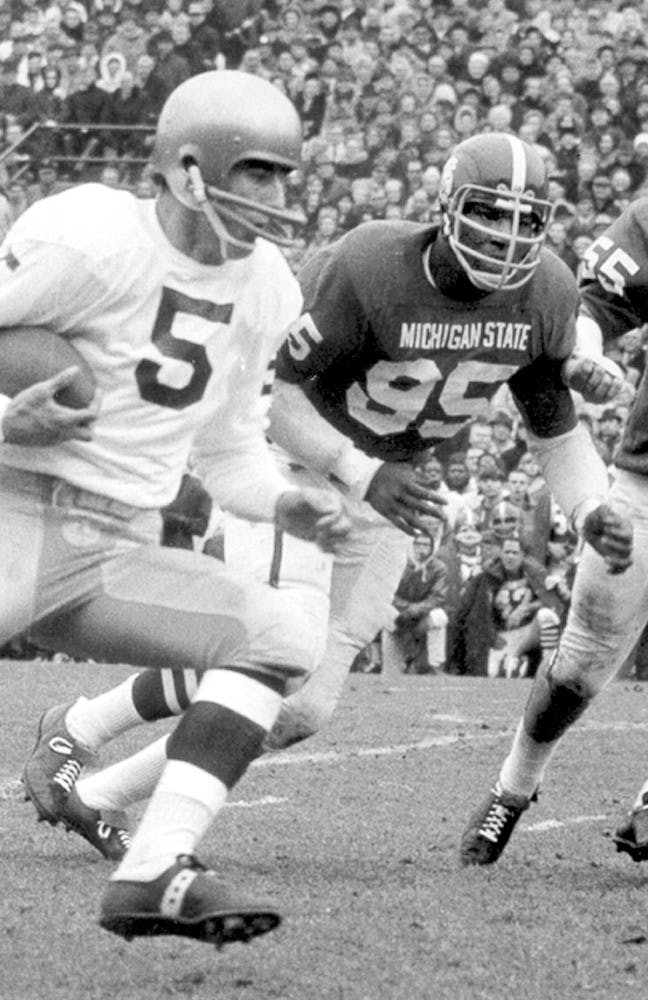At the height of the civil rights movement, two teams came together on the gridiron to battle for the bragging rights of calling themselves the true No. 1 overall team on Nov. 19, 1966.
One school was a predominantly white catholic school. Their opponent — a melting pot with high amounts of black talent.
Though the game ended in a tie, the Game of the Century brought together multiple races to battle.
The MSU running back during the game, Clinton Jones, said the players had no care for any race disputes. Jones said the intensity on the game was strictly because of both teams’ competitiveness.
“Our attitude for playing against them had nothing to do with race at all, that wasn’t an issue,” Jones said. “We knew we were number one before and after the game.”
Flashback to Feb. 11, 1965, Martin Luther King Jr. came to MSU’s campus to spread his message of racial inequality, and more than 4,000 students showed up to hear King speak.
Though people were aware of segregation and other racial problems, MSU football found a way to avoid the racial tension in the mid-60s.
With players coming from various parts of the country and white and black players intermixed on the same team, Jones worked as a glue between both races. A popular figure on MSU’s campus, Jones was a member of Omega Psi Phi fraternity and was the first black student to be named Mr. MSU.
A common time of segregation was when the team ate, Jones said. Though black players ate with black players and white with white, Jones said he wanted to make friends with everybody, so he would go back and forth.
“One thing that always struck me was why people hated other people because of the color of their skin,” Jones said.
On the shores of Lake Erie in Ohio, Jones grew up in a mostly black neighborhood in Cleveland. He attended Cathedral Latin School, now called Notre Dame - Cathedral Latin, in the late 1950’s and early ‘60s.
While in high school, Jones said approximately 20 African-American students attended Cathedral Latin School. Jones said during this time he saw civil rights leaders speak, such as King and Malcolm X.
“Cleveland in the time I was growing up, and (it) is still like this today, was very racially divided,” Jones said.
Because of this, Jones said he has always stood for justice. Upon his arrival to campus, Jones and the rest of the freshman class was living in the brand new dorm, Wonders Hall.
Under the authority of head coach Duffy Daugherty, Jones said the team was put to the grindstone. The team had a lot of talent, evidenced by MSU football being named national champions in 1965 and 1966.
Though winning might have brought the team closer together, Jones said he isn’t sure how the team was able to pull together.
“It just materialized,” Jones said. “Looking back now, it was pretty amazing.”
One theory, Jones reminisced, goes back to his time in the Vietnam War.
In 1971, Jones went to Vietnam as part of a program by the Department of Defense, United Service Organizations and National Football League.
Jones said there was great disparity of racial behavior depending on how close a soldier was to the battlefield.
Support student media!
Please consider donating to The State News and help fund the future of journalism.
“Guys who are on the battlefield, regardless of their background, they are close because their lives depended on it,” Jones said. “But guys around the outsides in the rear bases, racism was rampant ... so was drugs and insubordination.”
Just as soldiers would fight for one another, Jones said the football team shared a similar bond.
“At Michigan State for us, that happened with us, we fought for each other and we developed a respect for each other,” he said. “I would give my life for my teammates, that’s the way I felt, it had nothing to do with race or anything.”
As Jones moved on to the Minnesota Vikings in the NFL, he said he learned more about his old teammates.
One of which was Jimmy Raye, the first black starting quarterback for MSU and was the first black quarterback from the south to win a National Championship.
In Tom Shanahan’s book, “Raye of Light,” Shanahan talks about Daugherty and how he acted as an underground railroad for black football players in the south. Raye, a native to Fayetteville, N.C., fought institutionalized segregation on his way of accomplishing his dream of playing higher level competitive football.ch
Stories such as Raye’s, Jones said, he didn’t know until the book was released.
Though Jones sees a lot of similar race problems today, his time at MSU was an umbrella to the growing frustrations.ch
“Racism is really a delusional systematic process to keep people down, primarily because of money,” Jones said. “It’s a tribal mentality.”
Discussion
Share and discuss “Former MSU running back Clinton Jones recalls tensions in Game of the Century” on social media.







